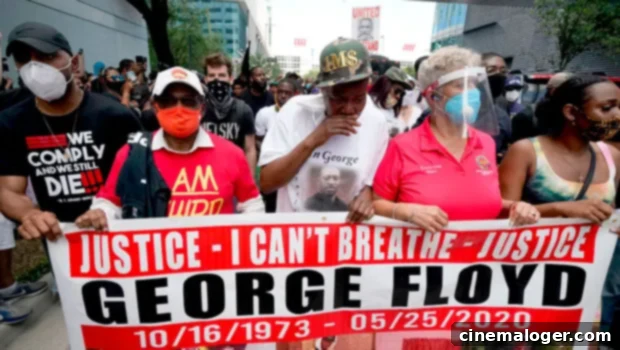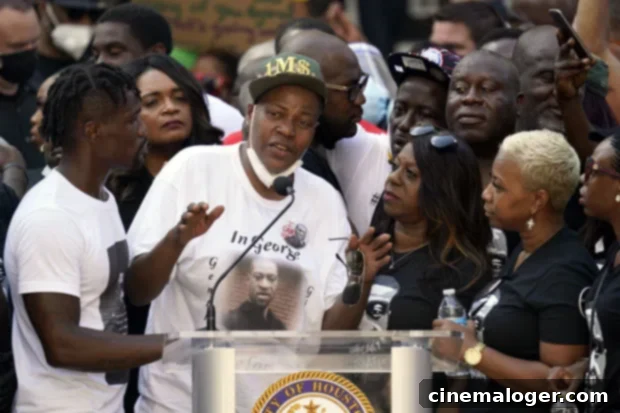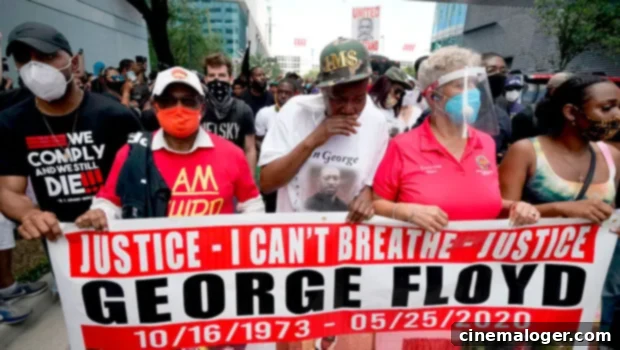George Floyd’s Legacy: A Call for Justice Echoes in Houston and Beyond
On June 2, 2020, the grief-stricken family of George Floyd united with hundreds of dedicated protestors in Houston, Texas, for a peaceful march. This poignant demonstration took place just eight days after George’s tragic death on May 25, an event that ignited a nationwide surge of protests against police brutality and systemic racial injustice. The march in Houston, a city George Floyd once called home, served as a powerful testament to the enduring impact of his life and the fervent demand for change.
As George Floyd’s family members, including his brothers Philonise and Terrence, walked arm-in-arm with community members near Discovery Green park, the air was heavy with sorrow but also charged with a resolute spirit of solidarity. Participants, many of whom had already spent days demonstrating across the country, stood by the grieving family, offering comfort and joining their collective voice in mourning George’s profound loss and advocating for a more equitable future. Emotional scenes from this pivotal day were widely captured and shared, symbolizing a nation grappling with deep-seated issues.

A Family’s Plea for Peace and Progress
Addressing the assembled crowd in their hometown, George’s brother, Philonise Floyd, spoke with raw emotion and unwavering conviction. “Never, never man I would thought it would have this many people man for my brother,” he conveyed, visibly moved by the outpouring of support. He emphasized the critical importance of peaceful protest, urging attendees, “I don’t want nobody to be protesting violently…You’re saying it in all our names not just his name. It’s bigger than my brother.” Philonise’s words resonated deeply, underscoring that the movement transcended a single individual’s tragedy, representing a broader fight for human dignity and justice.
Philonise continued, reflecting on the future, particularly for the younger generation. “We got kids growing up,” he stated, referencing George’s six-year-old daughter, Gianna, who became a poignant symbol of the movement. “Sooner or later they’re gonna be trying to figure it out and they’re gonna say, ‘Man, we’re next.’ We’re trying to break the cycle right now. We got this.” His powerful message highlighted the intergenerational struggle against systemic oppression and the collective responsibility to forge a better world for children. He concluded by expressing profound gratitude, “Man, I thank y’all for your kind words and support…I love y’all…I wouldn’t be here if it weren’t for y’all. I’d be in a shack, that’s tied up, sitting down. I’m hurt. I love my brother.” Other family members, including George’s brother Terrence Floyd, also shared inspirational messages, reinforcing the family’s call for unity, peace, and sustained action.
The Houston march wasn’t a spontaneous gathering; it was carefully organized and announced to the community. Days prior, on May 31, a supporter of the Floyd family took to Instagram to inform the Houston community about the planned event. The post invited “The Whole City To Be Part, All People All Races, All Humanity… We Will Do It Right For The Homie…. 3pm we will meet at Discovery Green, Please Send To Everyone,” adding the hashtag “George Floyd.” This digital call to action swiftly mobilized thousands, demonstrating the power of social media in galvanizing public support and organizing large-scale demonstrations in the pursuit of racial justice and police accountability.

The Tragic Events Leading to a Global Outcry
The Houston march, and countless others like it, emerged in the devastating aftermath of George Floyd’s death, which occurred over a week prior in Minneapolis, Minnesota. A Houston native, George Floyd was unarmed during an attempted arrest when he was pinned down by former officer Derek Chauvin. For excruciating minutes, Chauvin’s knee pressed firmly into George’s neck, despite his desperate pleas. George struggled throughout the ordeal, uttering the now-iconic and heartbreaking words, “please, please I can’t breathe” and “my stomach hurts…my neck hurts.” His cries for help went unanswered, and he eventually lost consciousness. He was transported by stretcher to Hennepin County Medical Center, where he was tragically pronounced dead at 9:25 pm.
The bystander video of George Floyd’s final moments quickly went viral, igniting immediate outrage and condemnation across the globe. The visceral footage forced millions to confront the stark reality of police brutality and its disproportionate impact on Black communities. This single incident became a catalyst, transforming simmering frustrations into a powerful, unified demand for fundamental societal change.
In response to overwhelming public pressure, Derek Chauvin was arrested on May 29, just four days after George Floyd’s death. He was initially charged with third-degree murder and manslaughter, charges that would later be elevated as the investigation progressed. Three days later, on June 1, an independent autopsy commissioned by the Floyd family offered a critical counter-narrative to initial official reports. The independent examination unequivocally concluded that George Floyd had died as a result of “asphyxiation from sustained pressure.” Ben Crump, the Floyd family’s attorney, shared this vital information on social media, emphasizing the horrific circumstances by stating that George was “dead on the scene” and that the “ambulance was his hearse,” highlighting the preventable nature of his death.
Terrence Floyd, George Floyd’s brother, spoke at the scene of his brother’s death in Minneapolis.
Latest updates: https://t.co/l3XSxxQvUH pic.twitter.com/A3Kh5tgCmz
— The New York Times (@nytimes) June 2, 2020
A Wave of Protests and Celebrity Advocacy
In the wake of George Floyd’s death, an unprecedented wave of protests swept across the United States and many parts of the world. Citizens and prominent public figures alike leveraged their platforms to loudly denounce racial injustice and demand an end to police brutality. Millions took to the streets, participating in peaceful marches, vigils, and demonstrations, all united under the banner of “Black Lives Matter.” These protests were not merely expressions of anger; they were urgent calls for comprehensive police reform, accountability for misconduct, and systemic changes to address racial disparities in the justice system.
High-profile celebrities and influential personalities also joined the chorus of voices advocating for justice. Stars like Gigi Hadid, LeBron James, and Beyonce utilized their massive social media reach to amplify messages of anger, dismay, and frustration, encouraging their followers to engage and support the movement. Beyond social media posts, many celebrities took direct action. Ariana Grande, Halsey, and Cole Sprouse, among others, actively joined protests in California and elsewhere, putting their physical presence alongside thousands of ordinary citizens, further validating the movement and drawing wider media attention to the cause. Their involvement underscored the widespread societal demand for change and lent significant visibility to the movement’s objectives.
Confrontation, Resilience, and the Path Forward
While the overwhelming majority of protests were peaceful, many demonstrations were met with a heavy police presence, which in some instances led to violent clashes. Across the country, citizens reported numerous accounts of excessive force from law enforcement, including the deployment of tear gas, rubber bullets, and aggressive crowd control tactics. Disturbingly, even journalists, whose role is to report on events, became targets of intense police action. Notably, CNN’s Omar Jiminez and his crew were arrested on live television while reporting from Minneapolis, an incident that sparked further outrage and raised serious concerns about freedom of the press and the militarization of police responses to civilian protests.
These confrontations, however, did not deter the spirit of the movement. Instead, they often galvanized protestors, reinforcing the urgency of their demands for systemic reform. The protests shone a bright light on the historical context of racial injustice and police misconduct in the United States, linking George Floyd’s death to a long lineage of similar tragedies and solidifying its place within the broader Black Lives Matter movement. The events of 2020 forced a national reckoning, leading to renewed calls for policy changes, legislative actions, and a fundamental reevaluation of policing practices.
As the conversations surrounding racial justice and police accountability continue to evolve, the legacy of George Floyd endures as a powerful symbol. The peaceful march in Houston, led by his grieving family, remains a poignant reminder of the human cost of systemic injustice and the unwavering resolve of communities demanding change. HollywoodLife, along with many other organizations, continues to encourage its readership to educate themselves, donate to relevant causes, and actively participate in the solution by exploring resources dedicated to combating racial inequality and promoting justice. The journey towards a truly equitable society is ongoing, and sustained engagement from all remains crucial for realizing the promise of justice for all.
